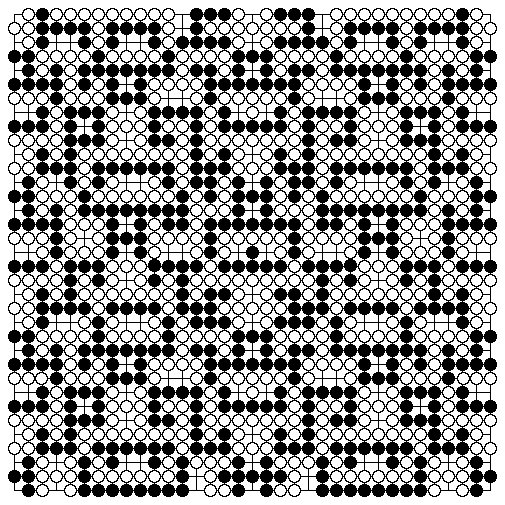 A
A
 B
B
"Stone-arrangement painting on the board No. 1 of 35 points by 35 rows"*(1999)
Work analysis (Not an interpretation.)
Picture size --- 35 points by 35 rows = 1,225 picture elements
Expression of picture elements --- Expressed by three values of "jis (=captured teritories)," "black stones," and "white stones."
Constituents --- 128 points of "Jis," 549 pieces of "black stones," and 548 pieces of "white stones."
Distinctive features --- A symmetric static picture. When seen as go, all are forming "sekis."
[Note] Go is a Japanese board game which aims to enclose jis. Especially when you enclose your opponent's stone or a group of stones by yours, you can capture the opponent's stone or stones, and the space becomes your territory called ji.
[Note] "Seki" is a stand-off situation where either side cannot do anything, as, if you try to capture the opponent's stone or a group of stones, yours will be captured contrarily.
Details of distinctive features as go (1) ---
The expression that "all are forming sekis" means that every stone and ji on the board is a part of constituent elements of a seki. As will be analyzed below, 53 sekis are all covering the board in this work. And either side cannot place even a single stone any more, and either does not have any group of stones which makes two or more valid eyes called mes (=two separate spaces within the group of stones). There are no dead stones nor simple "dames (=points that do not constitute territories)," (except "enclosed dames" which form sekis), all of which makes all on the board equally tense.
Details of distinctive features as go (2) ---
For trial, let's place one stone in any space in this work. (As a rule, spaces where you can place a stone are confined only to those in enclosed dames which form sekis.) And when you once place a stone, all stones involved in the seki which have formed the enclosed dame will be captured by the opponent. This means at the same time that a wall of another seki which has been adjoining to it will also be broken. This leads to so-called "seki crumbling" and all your stones involved in the seki will also be captured by the opponent. This causes a chain reaction all over on the board, and none of your stones will remain. This is not a simple defeat but an extinction.
Details of the structure as go ---
Let me use for convenience two charts as seen above: a chart of this work's structure (A), and a chart of the sekis (B), which was made on the basis of (A) by putting different colors to each group of sekis.
(a) All 53 sekis in this work are "sekis attacking each other."
(b) 25 sekis made by dark-blue-colored black stones and blue-colored white stones, and
6 sekis made by purple-colored black stones and light-purple-colored white stones, totally 31 sekis, are
sekis attacking each other which are of "the type of enclosing a dame having 2 points by both-side groups of stones which make no eye each other."
(c) 10 sekis made by red-colored black stones and orange-colored white stones, and
10 sekis made by green-colored black stones and yellow-green-colored white stones, and
2 sekis made by pink-colored black stones and light-pink-colored white stones, totally 22 sekis, are
sekis attacking each other which are of "the type of enclosing a dame having 1 point by both-side groups of stones which make 1 eye each other."
(d) Details of 128 points in "jis (=captured territories)":
Enclosed dames which form sekis ---------------- 31x2+22x1=84 ------ 84 points
The ones existing as groups of stones making one eye ---- 22x2=44 ---- 44 points
(e) Adjoining sekis form the other seki's wall each other.
(f) The result of calculation is as follows: As a general rule, none of the eyes inside a seki count as ji (=territory) for either side, so both sides gain 0 point, and therefore, neither wins nor loses (in the case when no stones are captured).

Stone-arrangement painting on the board No. 1 of 35 points by 35 rows*
Back to the top page of the Exhibition*
E-mail : nakazawa@aloalo.co.jp*

 A
A
 B
B